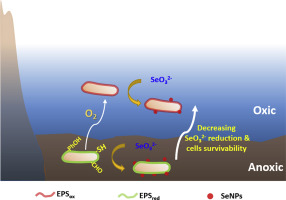Water Research ( IF 11.4 ) Pub Date : 2020-01-25 , DOI: 10.1016/j.watres.2020.115538 Xin Zhang , Wen-Yuan Fan , Mu-Cen Yao , Chuan-Wang Yang , Guo-Ping Sheng

|
In nature, many microorganisms show resistance to toxic selenite by reducing selenite to non-soluble and low toxic elemental selenium. Extracellular polymeric substances (EPS), a high-molecular-weight biopolymers originated from microbial metabolism, contain many reducing groups and can induce reductive transformation of pollutants. However, the roles of EPS and its redox state in reductive detoxification or reduction removal of selenite, respectively, remain unknown yet. Herein, the reduction of selenite by different sources of EPS was investigated. Selenite was proved to be reduced by EPS and partly transformed to elemental selenium. The formed elemental selenium was mainly selenium nanoparticles confirmed by transmission electron microscopy coupled with energy dispersive spectroscopy. The redox state of EPS governed selenite reduction and elemental selenium formation, and the reduced state of EPS was in favor of selenite reduction. Dissolved oxygen concentration in water regulated EPS redox state and influenced selenite reduction. The thiols, aldehyde and phenolic groups in EPS were responsible for selenite reduction. Under selenite stress, EPS was capable of increasing cell survivability by enhancing microorganisms-mediated selenite reduction. This work revealed the previously undiscovered roles of EPS in selenite reduction and elemental selenium formation in aquatic environments and also suggested a possible crucial role of EPS in selenium biogeochemical cycle.
中文翻译:

微生物细胞外聚合物质的氧化还原状态调节亚硒酸盐向元素硒的还原,同时增强水生环境中的微生物排毒
在自然界中,许多微生物通过将亚硒酸盐还原为不溶性和低毒性的元素硒而显示出对有毒亚硒酸盐的抗性。细胞外聚合物(EPS)是一种源自微生物代谢的高分子量生物聚合物,包含许多还原基团,并可以诱导污染物的还原转化。然而,EPS及其氧化还原状态分别在还原性脱毒或亚硒酸盐的还原去除中的作用仍然未知。在本文中,研究了通过不同来源的EPS还原亚硒酸盐的方法。事实证明,亚硒酸盐可被EPS还原并部分转化为元素硒。形成的元素硒主要是通过透射电子显微镜和能量色散光谱法确认的硒纳米颗粒。EPS的氧化还原状态控制亚硒酸盐的还原和元素硒的形成,EPS的还原状态有利于亚硒酸盐的还原。水中溶解的氧气浓度调节EPS的氧化还原状态并影响亚硒酸盐的还原。EPS中的硫醇基,醛基和酚基负责亚硒酸盐的还原。在亚硒酸盐胁迫下,EPS能够通过增强微生物介导的亚硒酸盐还原作用来提高细胞存活率。这项工作揭示了EPS在水生环境中亚硒酸盐还原和元素硒形成中尚未发现的作用,并且还暗示了EPS在硒生物地球化学循环中的重要作用。水中溶解的氧气浓度调节EPS的氧化还原状态并影响亚硒酸盐的还原。EPS中的硫醇基,醛基和酚基负责亚硒酸盐的还原。在亚硒酸盐胁迫下,EPS能够通过增强微生物介导的亚硒酸盐还原作用来提高细胞存活率。这项工作揭示了EPS在水生环境中亚硒酸盐还原和元素硒形成中尚未发现的作用,并且还暗示了EPS在硒生物地球化学循环中的重要作用。水中溶解的氧气浓度调节EPS的氧化还原状态并影响亚硒酸盐的还原。EPS中的硫醇基,醛基和酚基负责亚硒酸盐的还原。在亚硒酸盐胁迫下,EPS能够通过增强微生物介导的亚硒酸盐还原作用来提高细胞存活率。这项工作揭示了EPS在水生环境中亚硒酸盐还原和元素硒形成中尚未发现的作用,并且还暗示了EPS在硒生物地球化学循环中的重要作用。











































 京公网安备 11010802027423号
京公网安备 11010802027423号